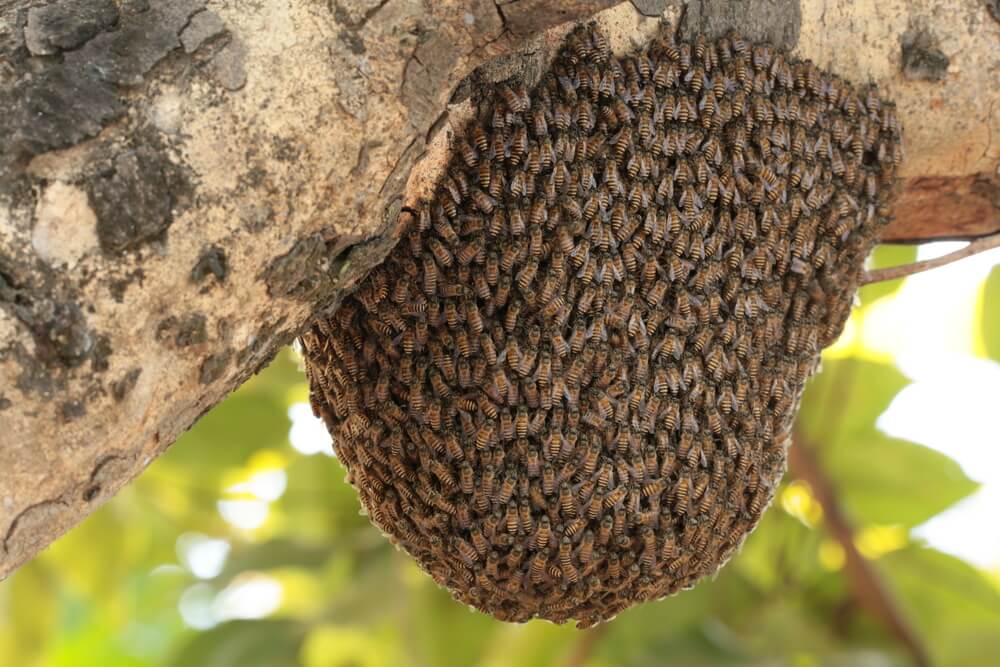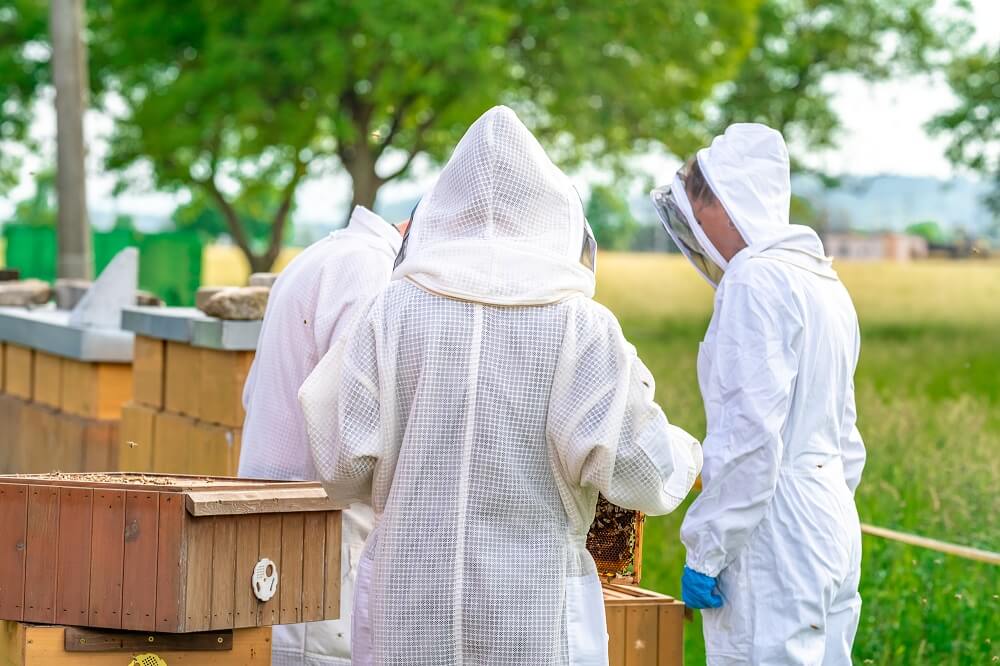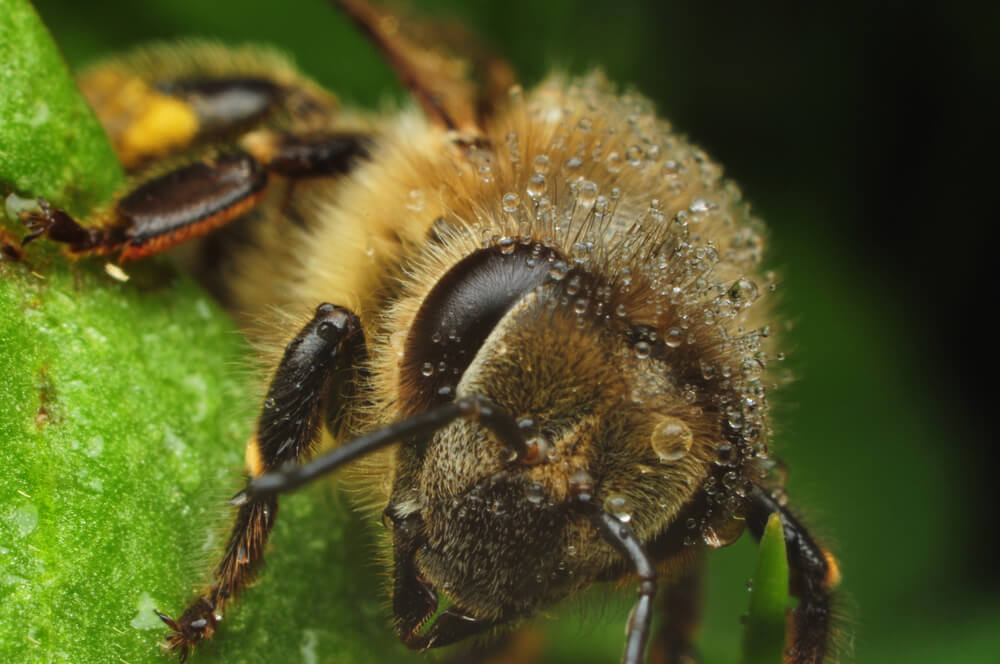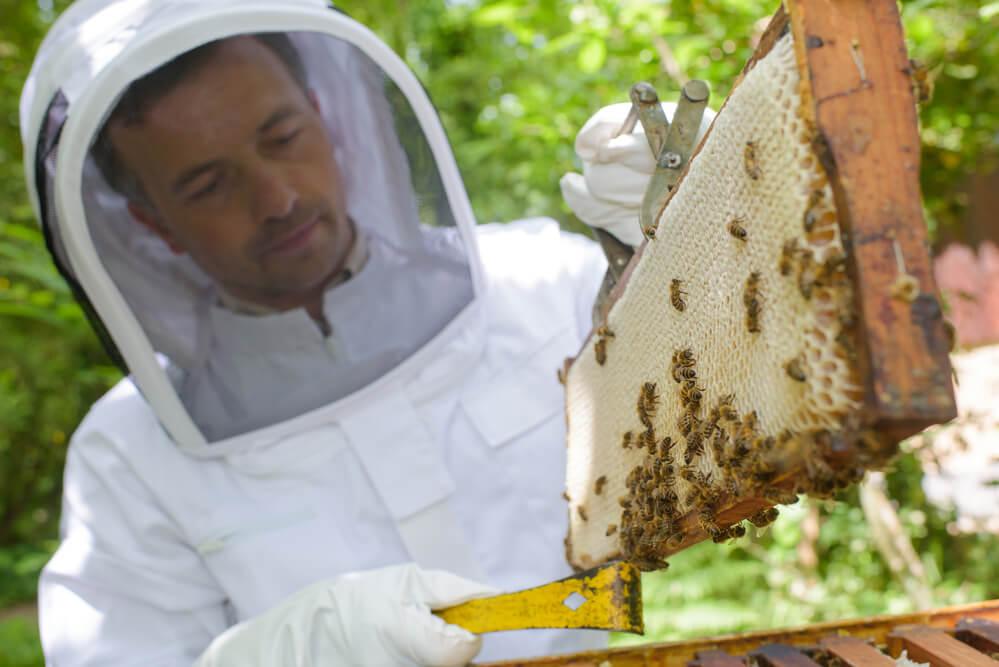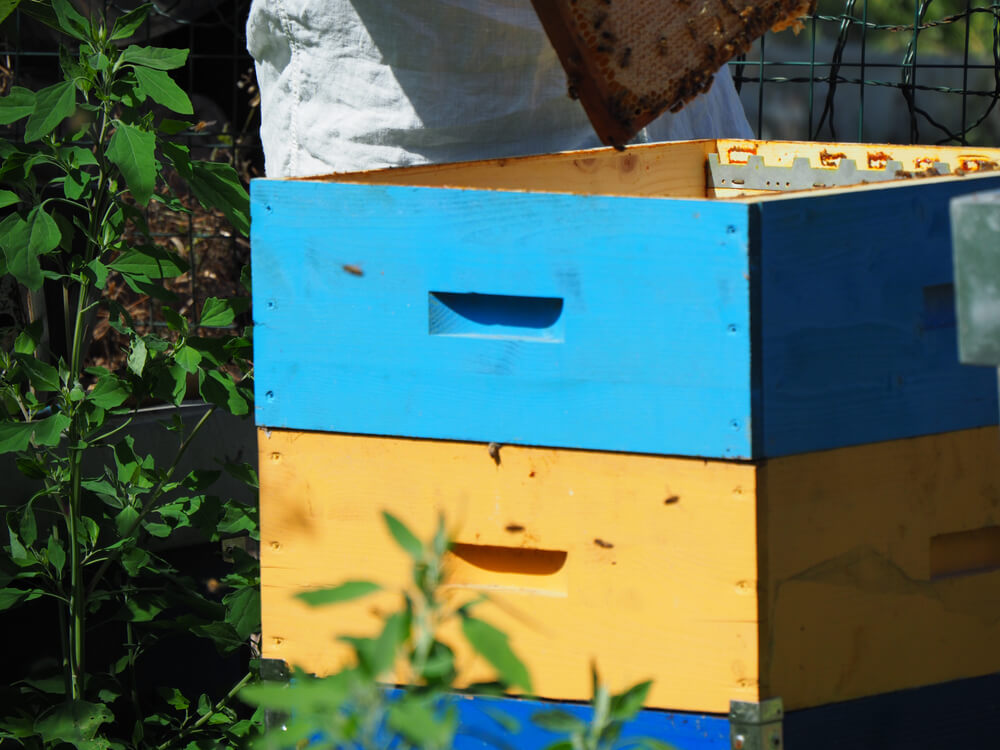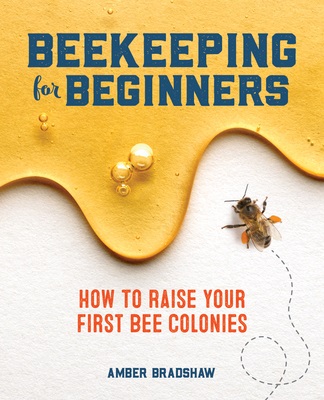Table of Contents:
What Is a Honeybee Swarm?
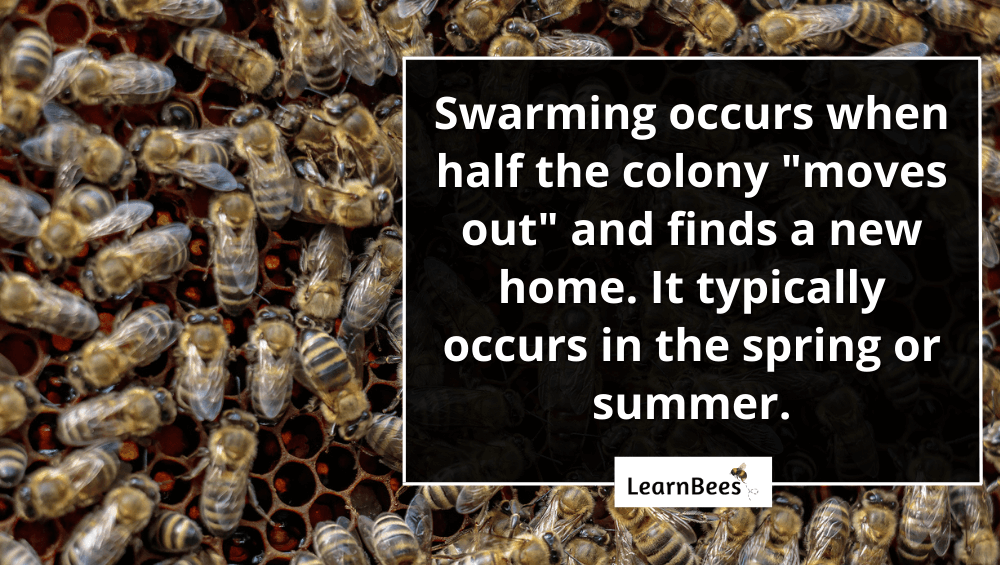
A honeybee swarm is when one colony splits into two colonies. Basically, half the colony “moves out” and finds a new home.
Why does this happen?
Two reasons.
Either the honeybee colony has become too congested with too many bees, or the colony wants to split so it can reproduce.
Swarming typically happens in the peak spring or summer months. However, the swarm preparation begins weeks before it happens. Special “queen cells” are created once the colony decides it needs to swarm.
You guessed it.
Queen cells are made to hatch a new queen.
The old queen leaves during the swarm and takes half the colony with her. Meanwhile, a new queen hatches and stays with the colony left behind.
But that’s not all.
The swarming queen bee is too heavy to fly away at a moment’s notice.
As such, the worker bees put her on a “diet” where they feed her less, and in turn, she stops laying eggs. This reduces her weight and allows her to fly more easily.
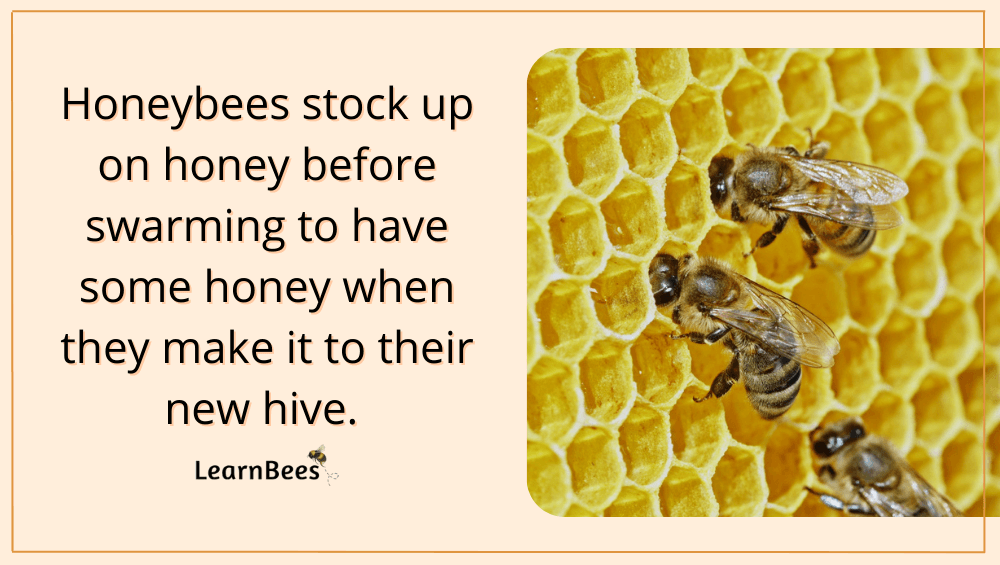
But the honeybees can’t leave empty-handed.
So the swarming bees gorge themselves on honey to take with them to their new home. They have a special internal organ called a ‘honey crop’ where they store the honey.
Think of it like packing a lunch box before a trip.
Swarms typically land on something close to their original hive – a tree, bush, or sometimes a man-made structure. Meanwhile, the colony sends out special ‘scout bees’ to search for a new nesting location.
Think of scout bees as real estate agents. Their job is to find the right home for their colony.
Once the new hive location is picked, the swarm moves in and starts building comb, laying eggs, and collecting food. Honeybees typically nest above ground in places such as empty tree cavities.
How Long Do Bees Stay in Swarms?
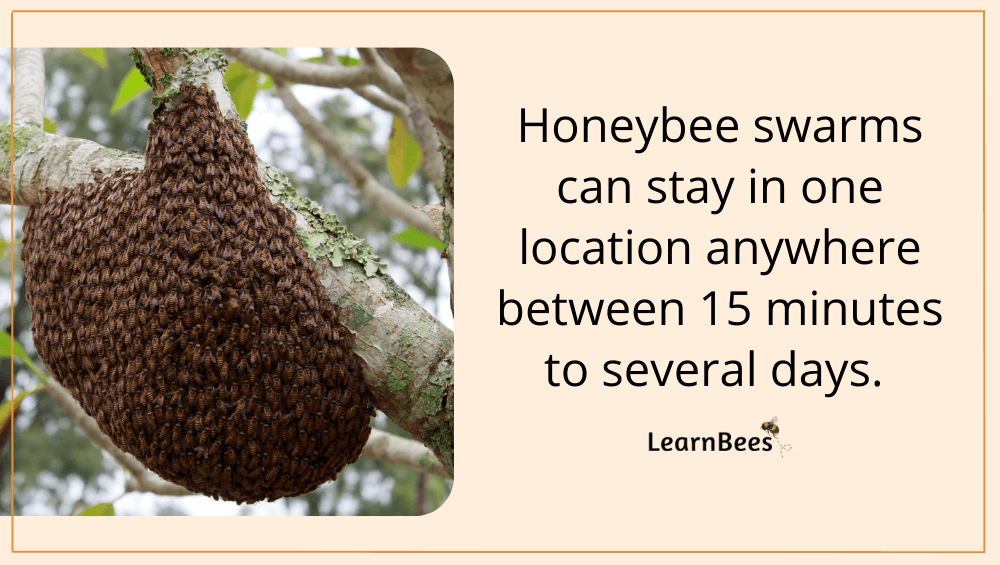
Swarms may stay in place for anywhere between 15 minutes to several days.
It just depends on how long the scout bees take to find a new home for the colony.
But here’s the thing:
Before a beehive settles into a swarm, it’ll first start as a cloud of buzzing bees.
From there, it usually takes the bees about 15 minutes to settle down into a swarm cluster on a branch or other steady surface. This is where they’ll wait until the scout bees find a new nesting spot.
And keep in mind:
Honeybee swarms contain thousands of bees in them. This is because the hive needs the help of many bees to rebuild its home.
The queen bee can be found in the center of the swarm cluster. The worker bees huddle around her to protect her from predators and the natural elements such as wind or rain.
What Do You Do if You See a Bee Swarm?

The answer?
Nothing.
Swarming is the natural process honeybees use to reproduce. And despite popular belief, honeybee swarms don’t want to sting you. They’re not in defense mode because they don’t have a hive, eggs, or honey to protect.
Instead, they’re in a limbo stage, trying to find a new home.
So don’t panic.
That said, you want to give the bees some space so they don’t feel like you’re trying to hurt them. Besides that, the bees simply need time to find a new place to live.
As mentioned, it can take anywhere from 15 minutes to several days for a bee swarm to find a new nesting spot.
If the bees are still there after a few days, you can call a local beekeeper to help relocate the swarm. Beekeepers love swarms because they’re essentially free bees.
FAQs on Bee Swarms
- What does a swarm mean in bees?
- What months do bees swarm?
- How do you stop a bee swarm?
- Are swarming bees aggressive?
- What time of day do bees swarm?
- What happens to the hive after a swarm?
- Should I let my bees swarm?
- Is swarming good for bees?
- Do bees swarm without a queen?
- Can a hive swarm twice?
- Can I put a swarm back into the hive?
- How do you tell if a beehive is going to swarm?
- How do you tell if your bees have swarmed?
- Can a bee swarm have two queens?
- When bees swarm do they all leave?
- How far do swarms go?
What does a swarm mean in bees?
It can mean two things.
For one, it can mean that the honeybee hive has gotten too populated and needs to be reduced to free up some space. Secondly, it can be the honeybee colony’s natural instinct to reproduce.
A swarm is a group of honeybees that have left their hive to find a new home. Typically, half the bee colony goes in search of a new home. Swarming is usually a sign that the colony is strong and well-established.
Some subspecies of honeybees – such as Africanized or Carniolan bees – are more likely to swarm. Other subspecies of honeybees – like Caucasian and Buckfast – are less likely to swarm.
Given the right conditions, most wild honeybee colonies can swarm more than once a season.
—> Go back to the FAQs on bee swarms
More to Explore:
What months do bees swarm?
In most places, swarming happens from late spring to early summer. Beekeepers call this “swarm season.”
That said, swarming can happen at other times of the year depending on the weather conditions and the bee species. For example, in tropical climates, swarming can happen year-round.
In colder climates, honeybees are not active during the winter months, so swarming will not happen during that time.
—> Go back to the FAQs on bee swarms
More to Explore:
How do you stop a bee swarm?
Here’s the thing:
Preventing a bee swarm isn’t easy.
Honeybees are hard-wired to swarm. Sometimes this occurs when there is overcrowding of the hive. Other times, swarming occurs as an act of reproduction.
If your colony wants to reproduce, the swarm preparation has been going on for weeks before it actually happens. In this case, preventing a swarm with a reproductive urge can be challenging.
As a result, most of the steps you take will only delay the swarm instead of preventing it.
If your colony wants to swarm due to over congestion, anything you do to reduce crowding will help:
- An upper entrance provides better ventilation and reduces congestion at the lower entrance
- Screened bottom boards provide better ventilation – as well as separate mites from the colony
- Slatted racks provide the bees with more room to cluster in the brood nest
- Empty supers give room above the brood nest to store honey
- Burr comb built between the frames should be cut off. Burr combs can block the queen from moving around easily
- Follower boards between the brood box and frames allow the bees to have more room to cluster
- Reversing hive bodies keep the brood nest lower and provide space above the brood nest for honey
These tips may help you prevent a swarm, but they aren’t foolproof. Remember, sometimes you’ll only be able to delay a swarm – not prevent it.
—> Go back to the FAQs on bee swarms
More to Explore:
Are swarming bees aggressive?
No, swarms are typically not aggressive unless you threaten them.
A swarm of bees is more interested in finding a new home than attacking humans. They aren’t in defense mode because they don’t have eggs, honey, or a hive to protect.
If you see a bee swarm, it’s best to leave them alone. Don’t try to spray them or kill them. This will only make them angry and more likely to sting you. Give them plenty of space and time to find a new home.
Swarms typically last no more than a few hours, but sometimes it can take a few days before they find a new hive spot.
—> Go back to the FAQs on bee swarms
More to Explore:
- How Many Bees Are in a Hive?
- What is Backyard Beekeeping?
- Honey Extractors 101: Everything You Need to Know
What time of day do bees swarm?
Honeybees are active during the daytime, so that’s when swarms happen. More specifically, bee swarms typically occur in the late morning or early afternoon.
The bees typically pick a warm, sunny day to swarm. Bees don’t like rainy or windy weather, so they avoid it at all costs. This is because heavy rain can get their wings wet and slow them down. Additionally, it’s dangerous for them to fly in high winds.
—> Go back to the FAQs on bee swarms
More to Explore:
What happens to the hive after a swarm?
If the hive successfully finds a new home, it’ll start building comb and doing regular beehive activities such as expanding the hive and collecting food.
—> Go back to the FAQs on bee swarms
More to Explore:
Should I let my bees swarm?
For starters, you may not have a choice. Sometimes the best you can do is delay the swarm – not prevent it. This is because honeybees are naturally hard-wired to swarm to reproduce.
That said, some beekeepers do choose to let their hives swarm. They may do this for a few reasons:
- It’s a natural way for the hive to reproduce
- It helps reduce congestion in the hive
- The swarm can be collected and used to start a new hive
With that in mind, it also depends on your location.
For example, allowing your bees to swarm is no problem if you live in a rural area. However, if you live in an urban area, allowing swarming can be inconsiderate to your neighbors.
Man-made structures offer multiple attractive opportunities for honeybees to nest in. This can cause issues for neighbors allergic to stings or people with health problems.
Additionally, not everyone has the funds to pay for a beehive to be removed. This can put an extra burden on someone who is living paycheck to paycheck.
—> Go back to the FAQs on bee swarms
More to Explore:
Is swarming good for bees?
Yes, it’s a sign of reproductive success for a honeybee colony. It’s natural.
However, if you’re a beekeeper who lives in an urban area, you may want to prevent swarming, so your neighbors aren’t bothered by bees.
In short, it depends on your location and the preferences of those around you.
—> Go back to the FAQs on bee swarms
More to Explore:
- What is a Super for Bees?
- What Do Beginner Beekeepers Need?
- What Are the Langstroth Hive Dimensions?
Do bees swarm without a queen?
“How do you tell if a swarm has a queen?” is a common question we get asked.
Bees will not swarm without a queen. They rely on a queen to lay eggs and ensure the future generation of honeybees. So without a queen bee, the honeybee colony would not survive.
—> Go back to the FAQs on bee swarms
More to Explore:
Can a hive swarm twice?
Yes. Multiple swarms are not uncommon.
For example:
The primary swarm is the first and largest swarm of the season. Next, you can have secondary and tertiary swarms.
When the swarms happen multiple times, the old queen leaves with the primary swarm. The secondary and tertiary swarms may leave with unmated virgin queens. The timing of mating and swarming typically depend on your local weather conditions.
—> Go back to the FAQs on bee swarms
Can I put a swarm back into the hive?
If the bees swarmed due to overcrowding, then recombining would be a waste of the bee’s time and your time since the conditions that caused the original swarm would be recreated.
There’s also the fact that you now have a queen for each hive, so combining will result in one queen being killed by the other.
My suggestion would be to appreciate that you now have two healthy hives rather than one. Keep in mind that bees have a natural tendency to swarm, which needs a lot of management to avoid. Most of the time, you can’t prevent a swarm, only delay it.
—> Go back to the FAQs on bee swarms
How do you tell if a beehive is going to swarm?
There are a few signs:
- A large amount of food is stored inside the hive, with little room for more
- A lack of comb space for brood rearing
- A large population of bees – especially ‘idle’ worker bees
- The construction of queen cells (queen cups), which are on the lower and side edges of brood combs
- Queen cell caps with eggs or larvae in them
—> Go back to the FAQs on bee swarms
How do you tell if your bees have swarmed?
The only way to know is to inspect the hive.
Here’s a video demonstrating how to tell if your bees have swarmed:
—> Go back to the FAQs on bee swarms
Can a bee swarm have two queens?
Finding more than one queen in a swarm is uncommon.
It can happen outside of a bee swarm, but it usually only lasts for a limited time.
Two queens in a hive often happen when a supersedure cell hatches while the original queen is still alive. The virgin queen hatches and mates, then begin laying eggs beside her mother.
But as mentioned, this is typically a temporary situation lasting no more than a few weeks. In rare cases, it can last a few months.
—> Go back to the FAQs on bee swarms
When bees swarm do they all leave?
No, only a portion of the colony leaves during a swarm.
That said, it’s not uncommon to catch a bee swarm and then have them leave the next day. Swarms aren’t established, so they don’t have anything invested in their new location, such as combs, brood, or honey.
Thus, it’s easy for a bee swarm to pick up and leave if they don’t like their new home.
Additionally, a colony could leave due to something called ‘absconding.’ When the bees abandon their hive, it’s referred to as absconding. The queen and all of the bees depart with the hive. They may leave behind baby bees who can’t fly and unhatched brood.
This is a sign that something is wrong.
For example, an ant invasion, heavy mite load, or lack of forage can cause bees to leave.
—> Go back to the FAQs on bee swarms
How far do swarms go?
Swarms will initially cluster within a few hundred feet of their old hive.
